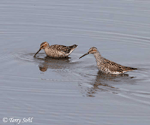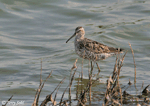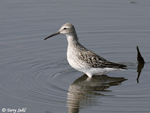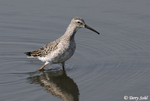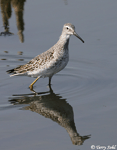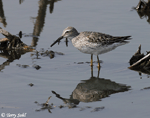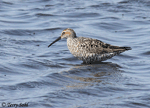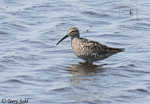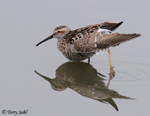Stilt Sandpiper
Calidris himantopus
| Length: 8 inches | Wingspan: 16 inches | Seasonality: Migrant |
| ID Keys: Chestnut ear patch and dark barring on underparts in breeding plumage, long bill drooped at tip are best marks. | ||
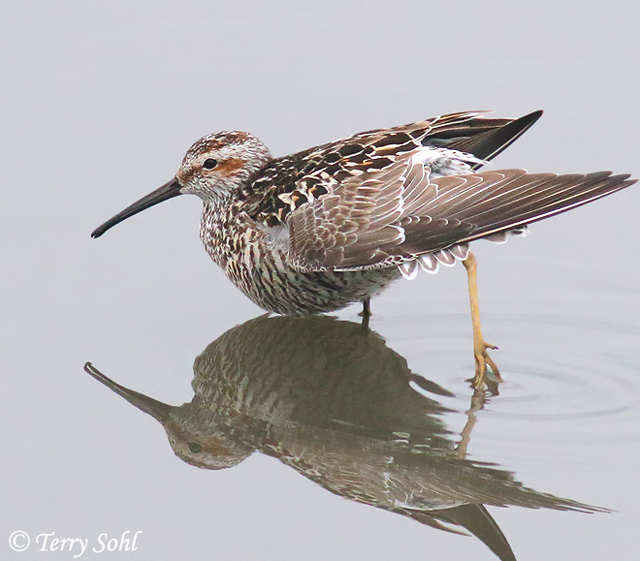 The Stilt Sandpiper is
very similar in shape to one of the yellowlegs,
but is more closely related to the tiniest of the sandpipers. When
feeding, they tend to act like a dowitcher,
probing mudflats and shallow water with their long bills. They are often less
shy than other sandpipers, a trait which led to a severe decline as hunters
targeted them in the 1800s. Their numbers have recovered nicely, however,
and are still thought to be increasing. They are a relatively common
migrant through South Dakota, as they prefer to forage in shallow freshwater
areas, not saltwater tidal areas like some of their relatives. The bird
shown to the right is dressed in the much drabber winter plumage. Birds in
breeding plumage are more brightly marked with distinctive chestnut colored ear
patches.
The Stilt Sandpiper is
very similar in shape to one of the yellowlegs,
but is more closely related to the tiniest of the sandpipers. When
feeding, they tend to act like a dowitcher,
probing mudflats and shallow water with their long bills. They are often less
shy than other sandpipers, a trait which led to a severe decline as hunters
targeted them in the 1800s. Their numbers have recovered nicely, however,
and are still thought to be increasing. They are a relatively common
migrant through South Dakota, as they prefer to forage in shallow freshwater
areas, not saltwater tidal areas like some of their relatives. The bird
shown to the right is dressed in the much drabber winter plumage. Birds in
breeding plumage are more brightly marked with distinctive chestnut colored ear
patches.
Habitat:
Breeds on wet meadows of the Arctic Tundra. In winter and in migration, they are most often found on shallow freshwater areas such as shallow ponds and lakes, and marshes with expanses of shallow open water.
Diet:
Feeds on a variety of items including aquatic insects and their larvae, marine worms, small crustaceans and mollusks, and parts of aquatic plants.
Behavior:
Feeds by wading in shallow water, probing in the mud below for food items, or plucking food items from the surface of the water.
Breeding:
Non-breeder in South Dakota. On their breeding grounds in northern Canada and Alaska, the nest is a shallow depression on the ground, with little nest building other than a cleared scrape that may have vegetative material present on the nest site itself. The male often makes several nest scrapes, with the female selecting the final nesting site. The female lays between 2 and 5 eggs, with both parents incubating them. The young hatch in about 20 days, and are able to fly about 2 1/2 weeks after hatching.
Song:
Usually relatively quiet, but capable of vocalizations consisting of musical, low twew notes and other calls. Also has a variety of coarse calls and whines on its summer breeding grounds.
1Click here to hear the calls of a bird in flight on its breeding grounds near Prudhoe Bay, Alaska
Migration:
Summers in the high Arctic. A few winter in the extreme southern U.S. along the Gulf and Atlantic coastlines and at the Salton Sea, but the majority migrate to South America.
Interactive eBird map:
Click here to access an interactive eBird map of Stilt Sandpiper sightings
Similar Species:
Lesser Yellowlegs - Stilt Sandpipers are smaller, and have a slightly drooped bill tip, while Lesser Yellowlegs have a thin, straight bill. Legs on a Lesser Yellowlegs are a much brighter yellow/orange.
Greater Yellowlegs - Stilt Sandpipers are smaller, and have a slightly drooped bill tip, while Greater Yellowlegs have a long bill that often appears to have a slight upturn. Legs on a Greater Yellowlegs are a much brighter yellow/orange.
Pectoral Sandpiper - Plumage is somewhat similar, but Pectoral Sandpipers have a much shorter bill, and the barring on the breast of a Pectoral Sandpiper has a sharp demarcation line between a cleaner white belly, unlike the Stilt Sandpiper that has much more extensive barring on its underparts.
Conservation Status:
Populations declined sharply in the 1800s and first half of the 1900s due to hunting and habitat loss, but they appear to be increasing in recent decades. The IUCN considers the Stilt Sandpiper to be a species of "Least Concern".
Further Information:
1) Patuxent Bird Identification InfoCenter, Stilt Sandpiper
2) WhatBird Guide - Stilt Sandpiper
3) Audubon Guide - Stilt Sandpiper
Photo Information:
May 26th, 2014 -- Near Madison, South Dakota -- Terry Sohl
Additional Photos:
Click on the image chips or text links below for additional, higher-resolution Stilt Sandpiper photos.
Audio File Credits:
1Andrew Spencer, XC203568. Accessible at www.xeno-canto.org/203568
2Doug Hynes, XC76187. Accessible at www.xeno-canto.org/76187
3Daniel Lane, XC77515. Accessible at www.xeno-canto.org/77515
| Click on the map below for a higher-resolution view |
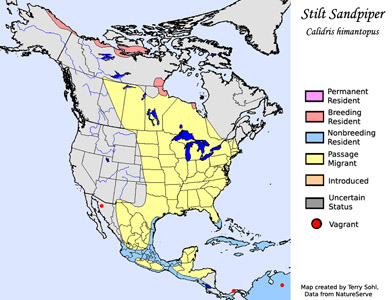 |
| South Dakota Status: Common migrant throughout the state. |
Additional Stilt Sandpiper Photos
Click for a higher-resolution version of these photos

